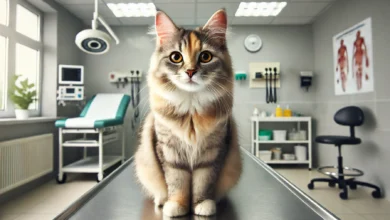Managing Cat Arthritis with Dietary Changes and Exercises

As cat owners, we want our feline friends to live happy and healthy lives, but just like humans, cats can suffer from arthritis as years go by.
Arthritis is a condition that leads to inflammation of joints and a painful state for your feline companion, which reduces their locomotion and keeps them in discomfort.
While it’s more common in aging cats, it can occur in felines regardless of age.
Fortunately, there are ways to manage cat arthritis through dietary changes and exercises.
This article describes how to enhance the quality of your cat’s life by making these adjustments and improving the comfort of their surroundings.
Table of Contents
Understanding Cat Arthritis: Causes and Symptoms
Feline arthritis is a degenerative joint disease that may be marked by pain, stiffness, and limited movement in your cat.
The signs are easily overlooked, not least because cats are skilled at disguising discomfort; hence, it is important to identify causes and symptoms early.
Arthritis can significantly affect your cat’s daily activities, and identifying its causes is the first step in managing the condition.
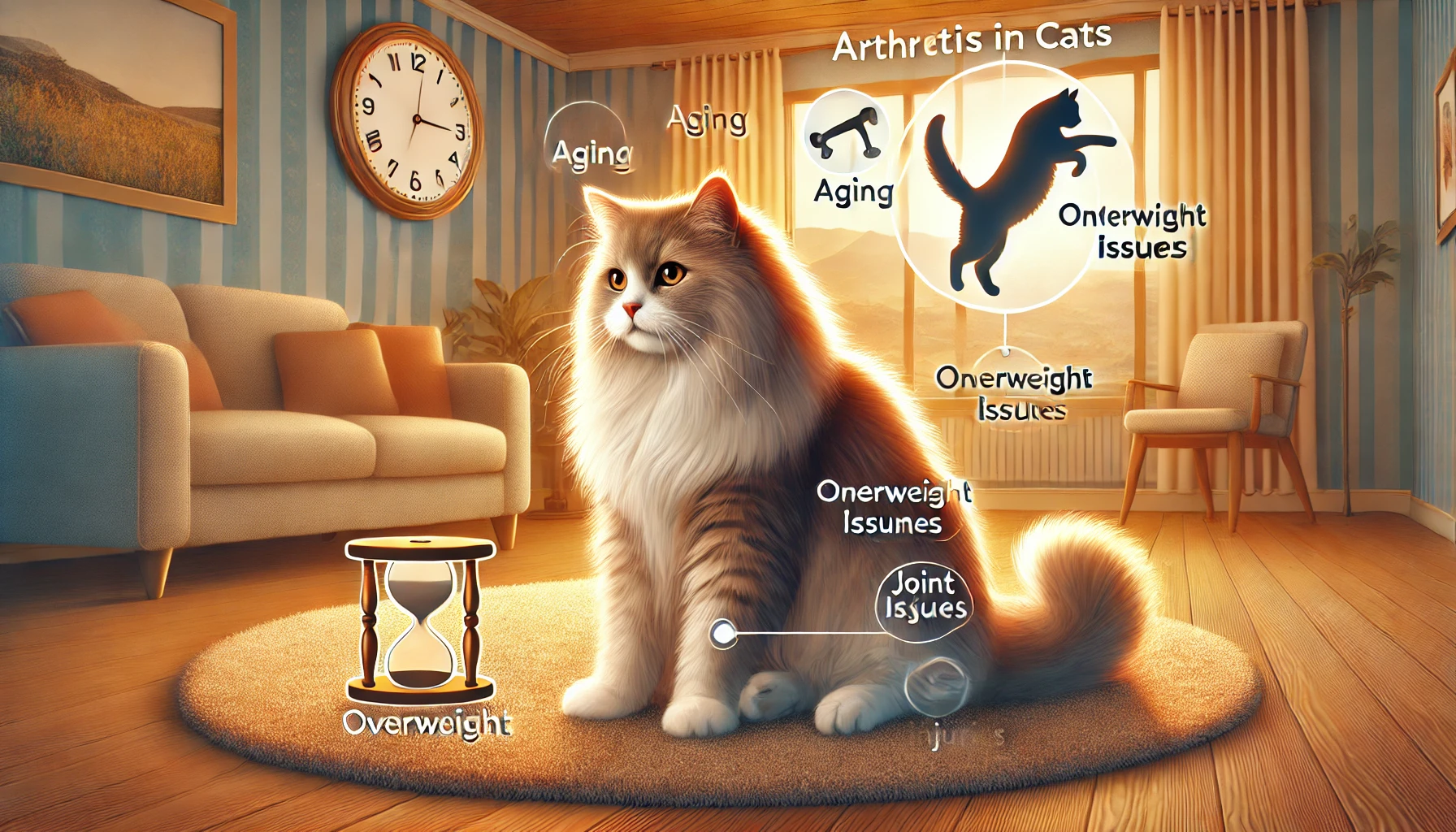
What Causes Arthritis in Cats?
Arthritis in cats has several causes, generally related to wear and tear on the joints over time.
While aging is the primary cause, other factors may contribute to its development.
Here are some common causes that may result in cat arthritis:
- Natural Aging Process: As your cat grows older, the cartilage in its joints may wear down, leading to arthritis.
- Joint Injuries: Previous injuries or trauma to the joints can lead to early arthritis in cats.
- Overweight: Excess weight puts additional pressure on your cat’s joints, increasing the risk of arthritis.
- Genetics: Certain breeds may have a genetic predisposition to arthritis.
- Developmental Factors: Birth defects like hip dysplasia can lead to arthritis over time.
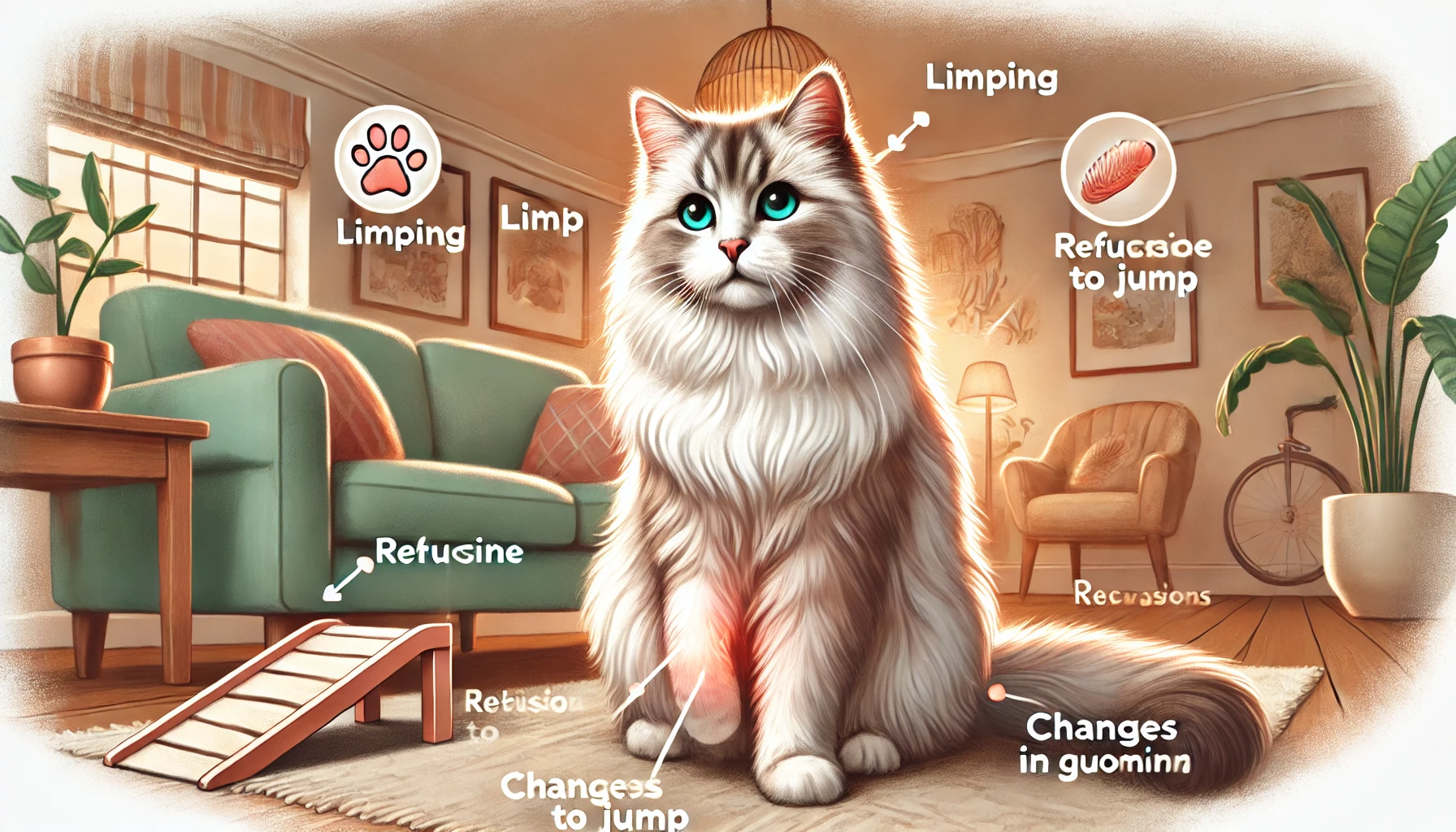
Common Symptoms of Cat Arthritis
Since cats are masters at masking pain, it’s difficult to notice arthritis until the disease has progressed.
However, there are several telltale signs your cat might be in pain due to arthritis:
- Limping: One of the more overt signs, limping may include favoring one limb while walking.
- Reluctance to Jump: Arthritic cats may avoid jumping onto furniture or have difficulty navigating stairs.
- Stiffness: Your cat may appear stiff, especially after rest or rising from a nap.
- Changes in Grooming Habits: Cats with arthritis may stop grooming certain areas because it’s painful, leading to matted fur.
- Irritability or Aggression: If your cat becomes unusually irritable when touched, especially around the joints, it may be due to arthritis pain.
Recognizing these symptoms and understanding the causes can help you take proactive steps to manage arthritis in your cat’s life.
The following sections will explore how diet and exercise play a crucial role in managing the symptoms of cat arthritis.
Recognizing the causes and symptoms of cat arthritis can help you take proactive steps in managing the condition.
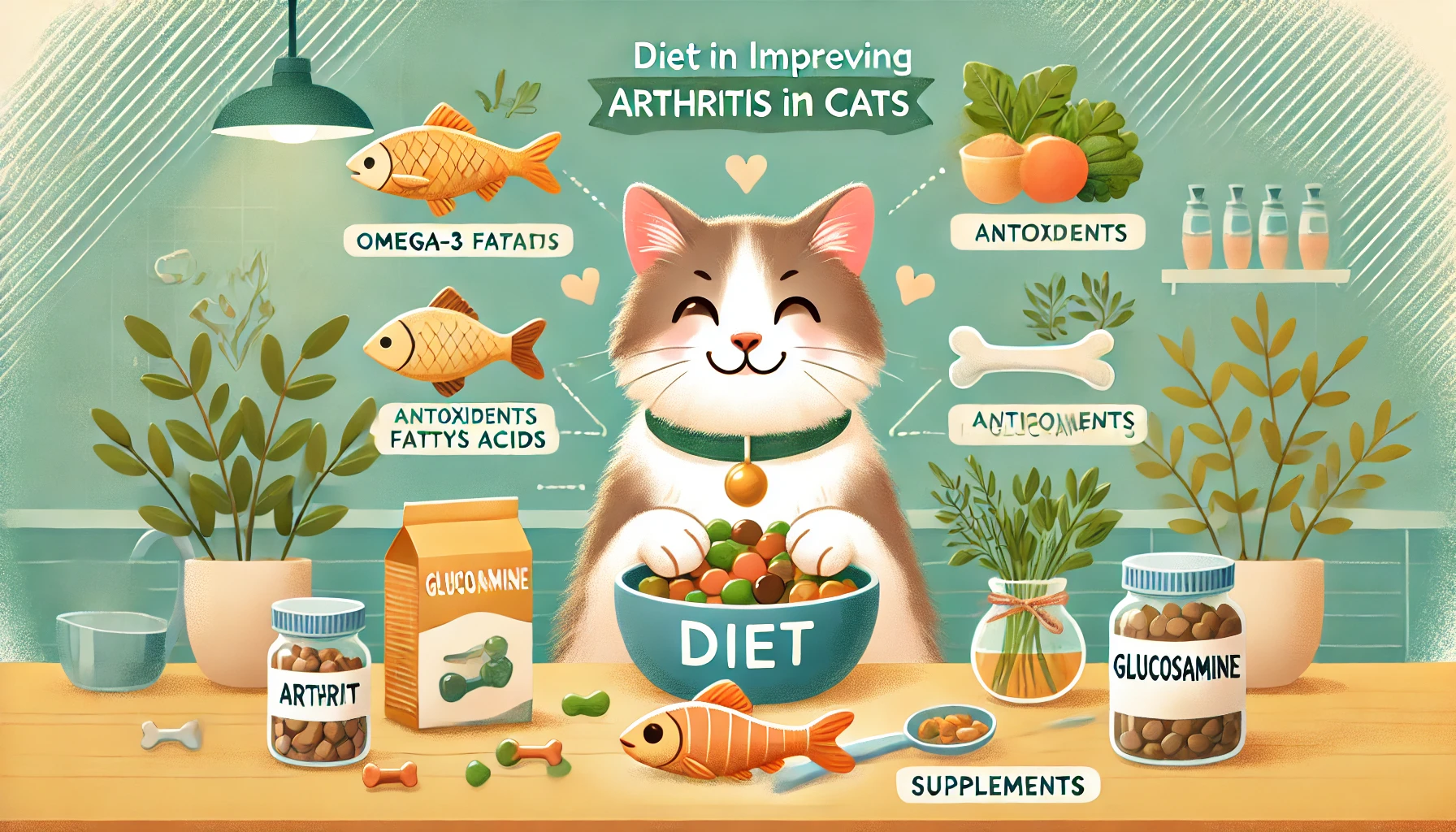
How Diet May Help Improve Arthritis in Cats
Just like humans, diet plays a very important role when it comes to the management of cat arthritis.
Feeding your cat the appropriate nutrients can help reduce inflammation, maintain healthy joints, and aid in managing pain related to arthritis.
Dietary modification is perhaps the best supportive method to help your cat, especially when integrated with other treatments such as exercise and medications.
Below, we will take a closer look at the dietary elements most important to potentially lessen your cat’s arthritis symptoms.
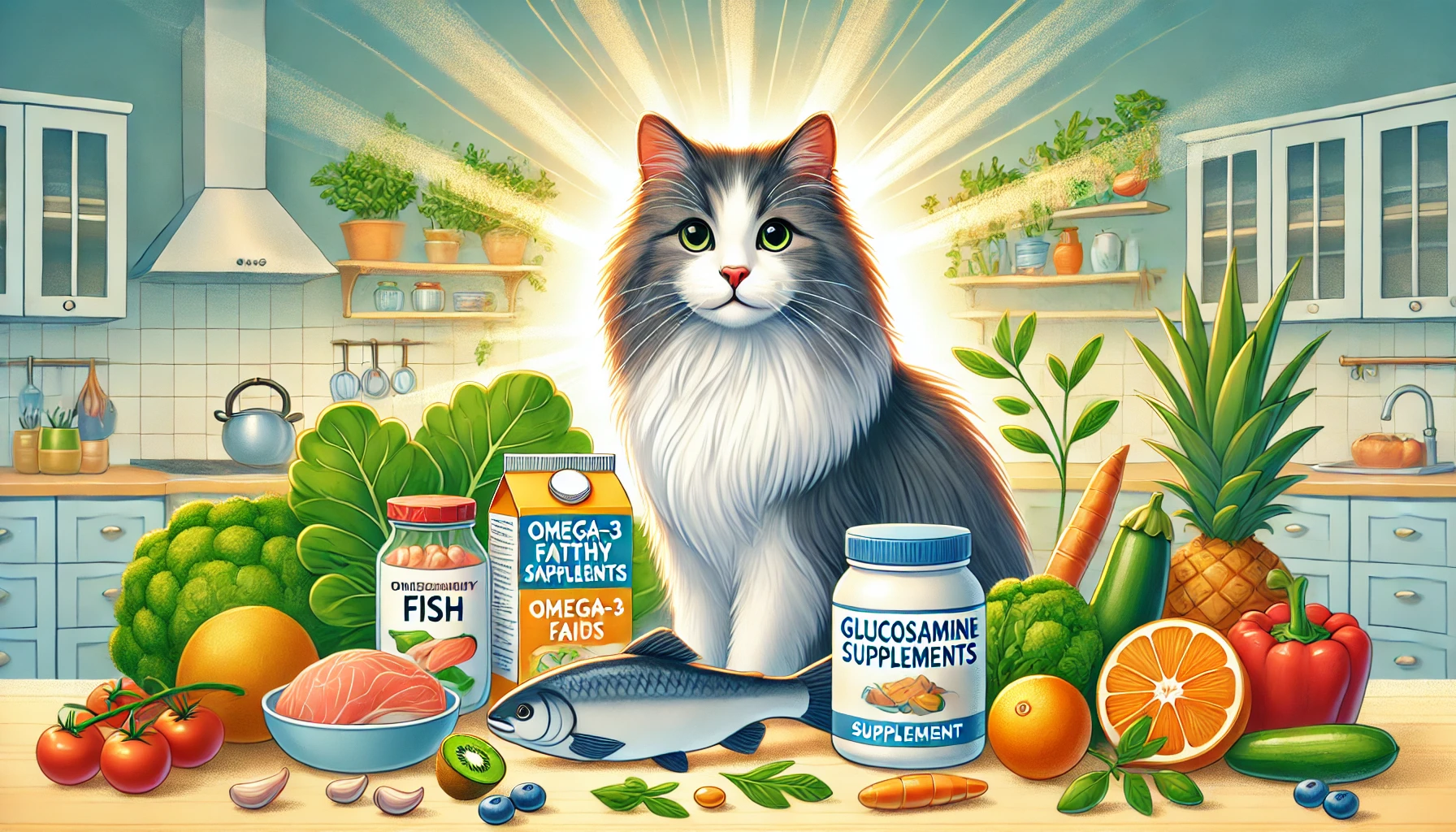
Nutritional Requirements for Joint Health
To manage arthritis in cats, it is important to provide foods rich in nutrients that can help both prevent and slow down joint degeneration.
These nutrients may facilitate cartilage repair, reduce inflammation, and preserve joint flexibility.
Some significant nutrients to add include:
- Omega-3 Fatty Acids: These anti-inflammatories, found in fish oils, help decrease inflammation and pain in the joints.
- Glucosamine and Chondroitin: These supplements, added to pet food, support cartilage repair and joint lubrication, making movement easier.
- Antioxidants: Vitamins such as Vitamin C and E reduce oxidative stress, which can lower inflammation within joints.
- Protein: High-quality proteins help maintain muscle mass, which supports the joints and reduces the strain on them.
- Collagen: Collagen helps maintain cartilage health and is becoming increasingly popular in pet foods for joint care.
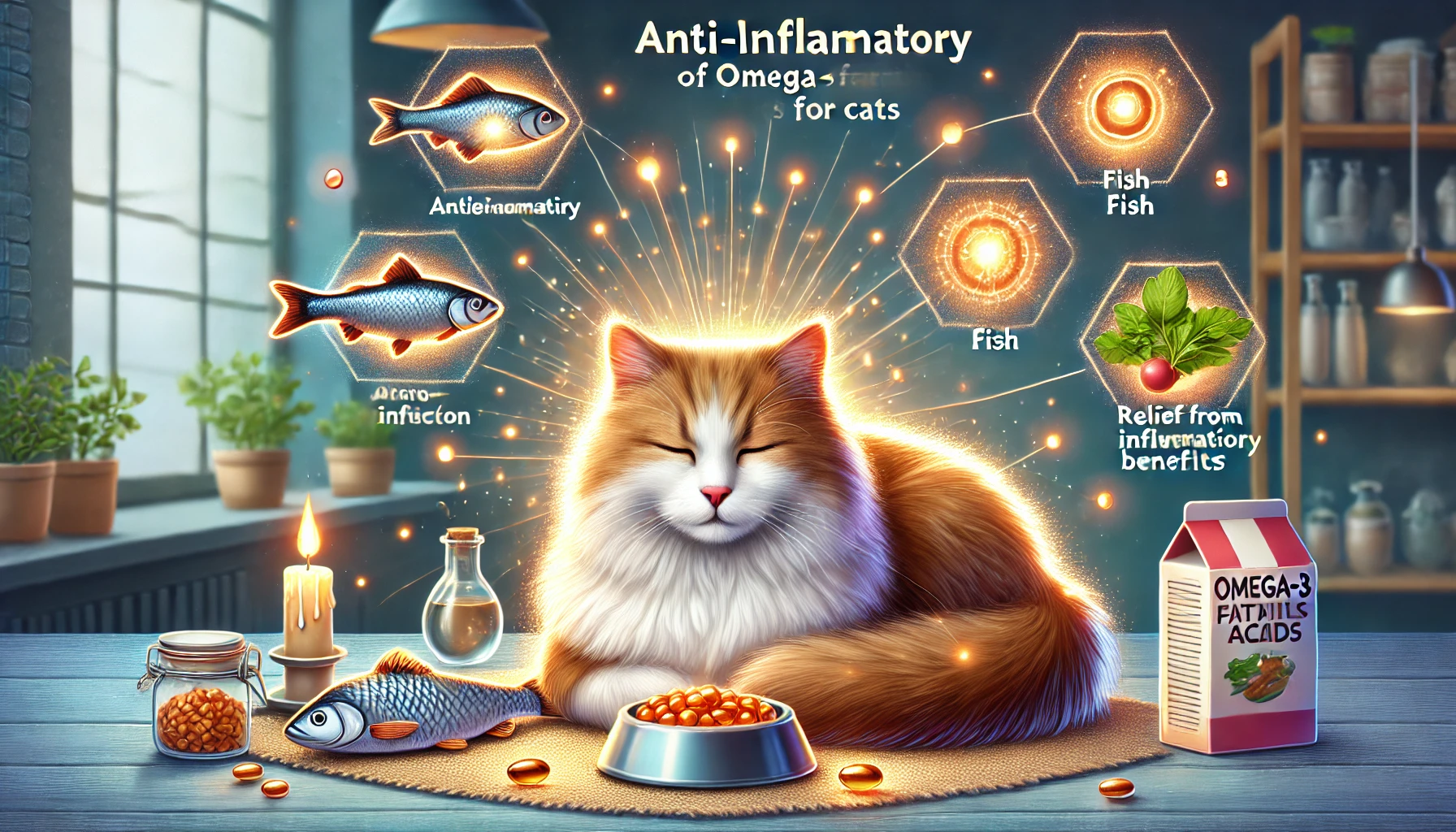
Omega-3 Fatty Acids’ Anti-Inflammatory Effects
One of the strongest defenses against cat arthritis is Omega-3 fatty acids, particularly from fish oil.
They reduce the production of inflammatory molecules, leading to less joint pain and swelling.
Studies show that a diet high in Omega-3 fatty acids improves the mobility of arthritic cats, reducing the need for medications.
Consider adding a fish oil supplement to your cat’s diet, or opt for cat food that already contains this beneficial ingredient.
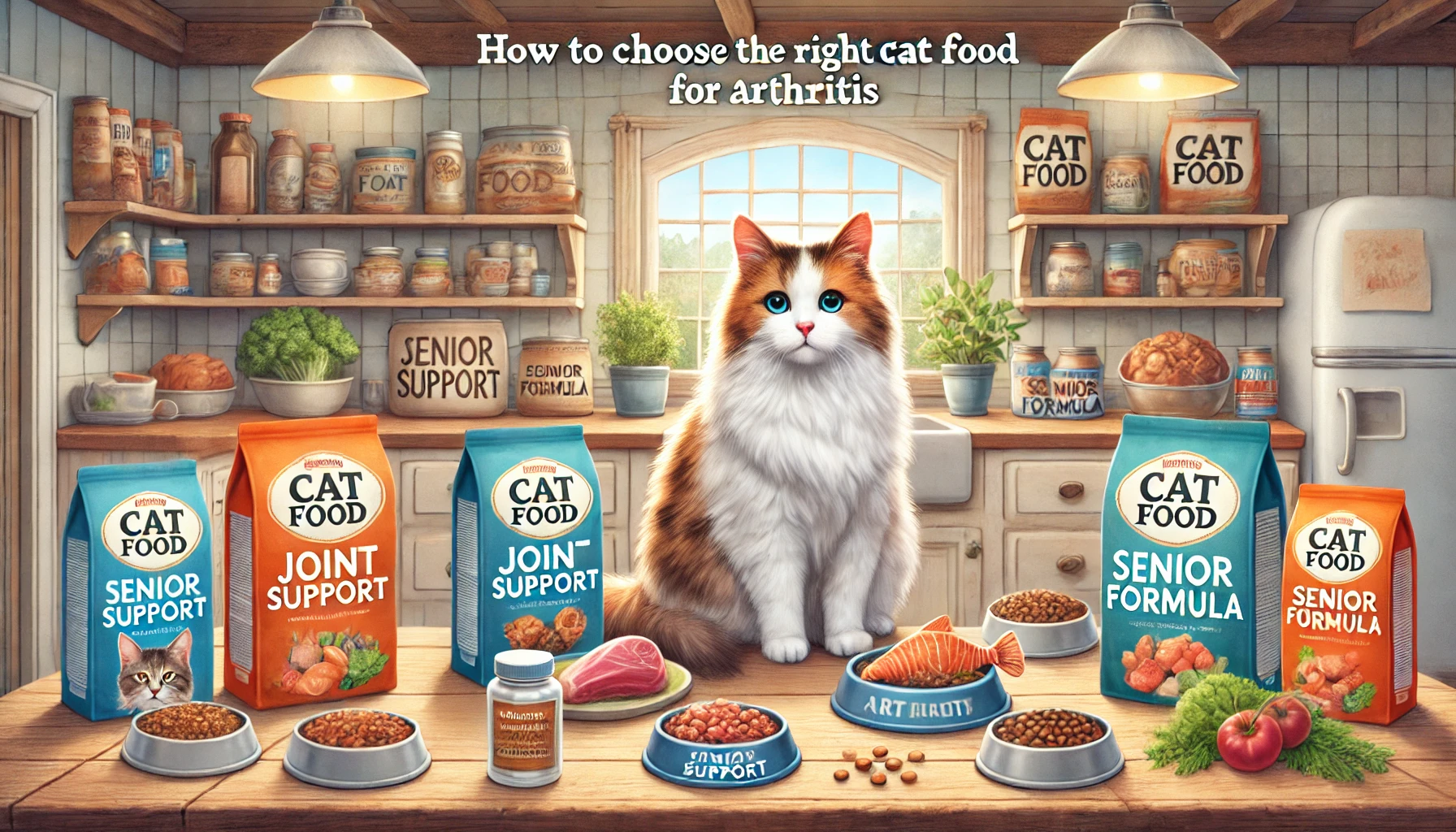
How to Choose the Right Cat Food for Arthritis
When selecting cat food to support your pet’s joint health, look for products containing the essential nutrients mentioned above.
Many brands now offer formulas specifically designed for senior cats or those with joint issues.
Here are some tips for choosing the best food for your arthritic cat:
- Ingredients: Always check the ingredient list for fish oil, glucosamine, chondroitin, and antioxidants.
- Avoid Excess Calories: Since obesity can worsen arthritis, choose food with fewer calories to support weight management.
- Wet Food: Wet food is easier for cats with arthritis to eat, requiring less chewing, and may help with hydration, important for joint health.
- Consult Your Veterinarian: Above all, consult with your veterinarian before making major changes to your cat’s diet to ensure it supports their arthritis management plan.
While diet alone can’t cure your cat’s arthritis, providing food rich in nutrients to support joint health can alleviate some symptoms and improve their quality of life.
Along with gentle exercises and proper veterinary care, a diet tailored to your cat’s needs can play a major role in keeping your arthritic cat comfortable and mobile.
Dietary changes, such as incorporating anti-inflammatory nutrients like Omega-3 fatty acids, can significantly reduce arthritis symptoms in cats.
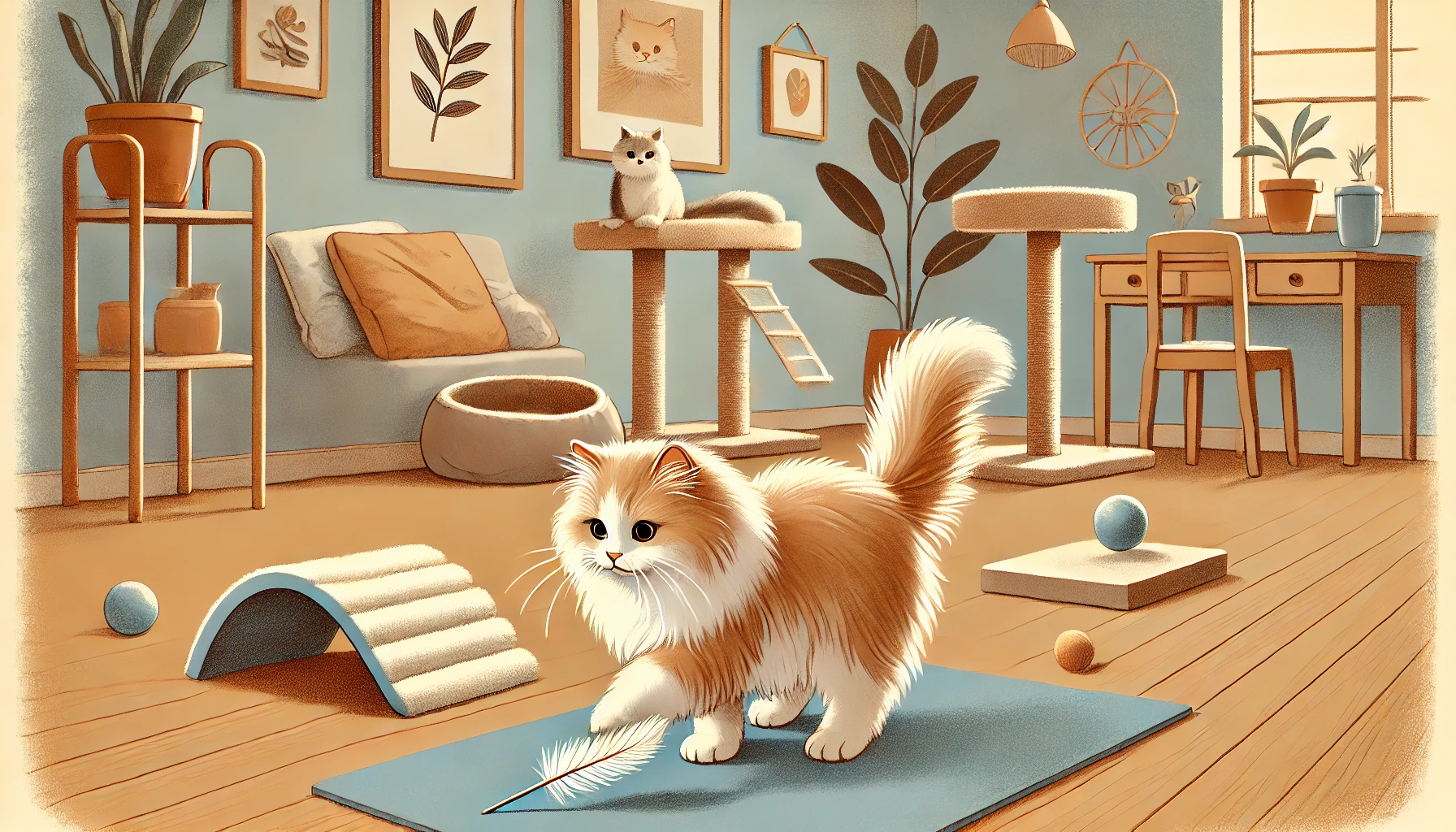
Exercises and Activities to Help Cats with Arthritis
A balance of exercise is important for cats with arthritis, but moderation is critical.
While too much activity can exacerbate the pain in your cat’s joints, gentle and consistent exercises will help keep the joints mobile and muscles strong.
Regular, low-impact activities improve flexibility, increase circulation, and can even reduce some of the pain associated with cat arthritis.
In this section, we will consider safe exercises and activities that can help manage arthritis symptoms and improve your cat’s quality of life.

Safe Exercises to Keep Your Cat Active
Keeping your arthritic cat active is crucial, but exercises should not further aggravate joint damage.
Here are some effective exercises for cats with arthritis:
- Short and Gentle Play Sessions: Interactive games with feather wands or laser pointers can get your cat moving while avoiding heavy strain on the joints.
- Low Jumps: If your cat loves to jump, allowing them to jump onto low surfaces maintains mobility with minimal impact on the joints.
- Hydrotherapy: Hydrotherapy can be a great low-impact exercise to improve joint movement and reduce pain, especially if your cat tolerates or enjoys water.
- Controlled Walking: Some cats benefit from gentle walking, perhaps on a leash, to keep them active without overexertion.
Each exercise should be modified based on your cat’s condition and energy level.
Start with shorter sessions and gradually increase the duration as your cat becomes more comfortable.
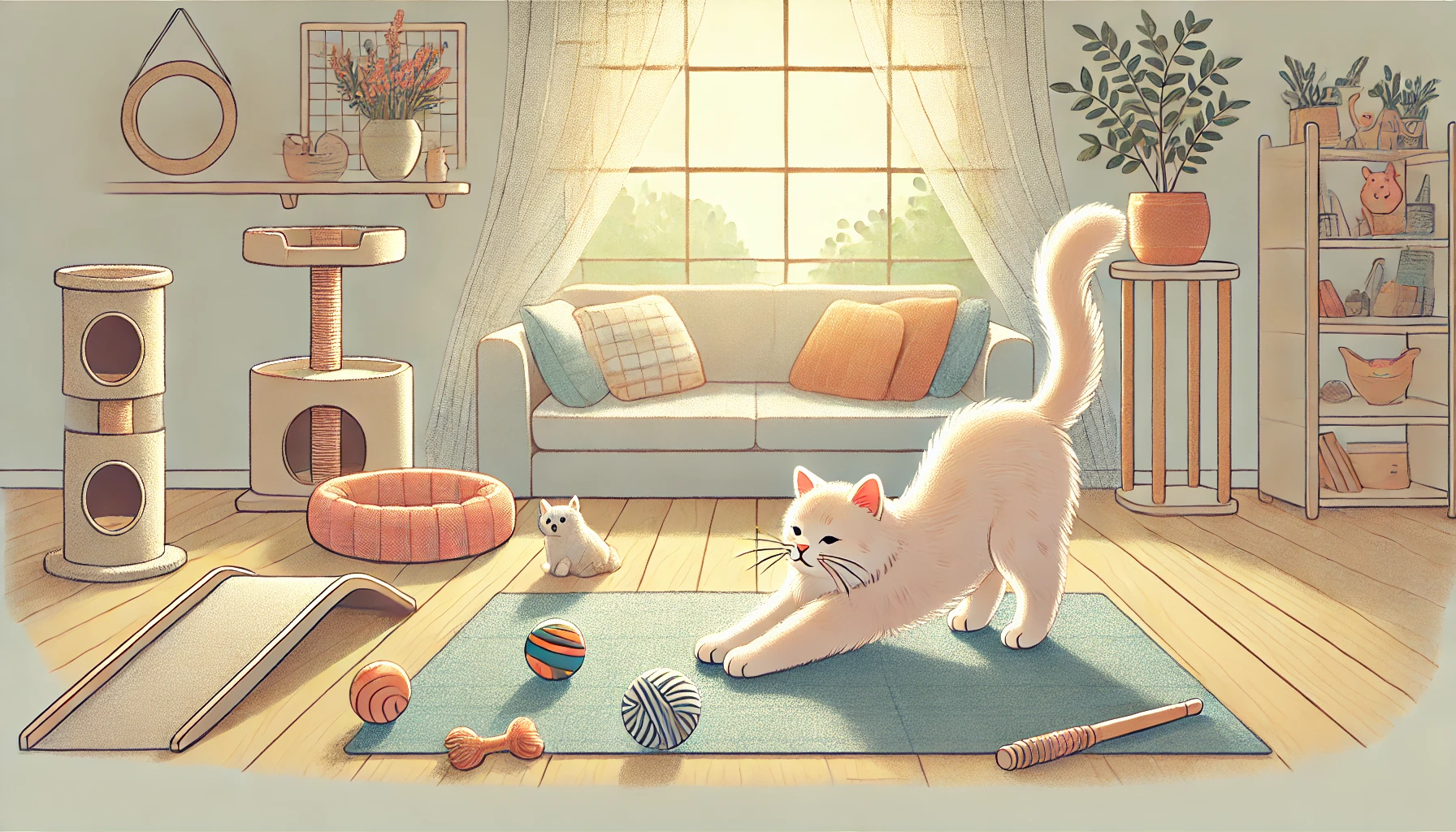
The Importance of Gentle Movement
Gentle movement is essential to keeping the joints flexible and preventing stiffness, especially in arthritic cats.
Inactivity can lead to muscle atrophy, worsening mobility.
You can encourage gentle movement in your cat by engaging them in stimulating activities without overexertion.
Some helpful strategies include:
- Slow, Controlled Stretches: Encouraging natural stretching through participatory toys can improve joint flexibility.
- Environmental Enrichment: Create an environment with different textures and levels for your cat to explore at their own pace.
- Multiple Breaks: Allow plenty of rest between activities to avoid overstressing your cat’s joints.
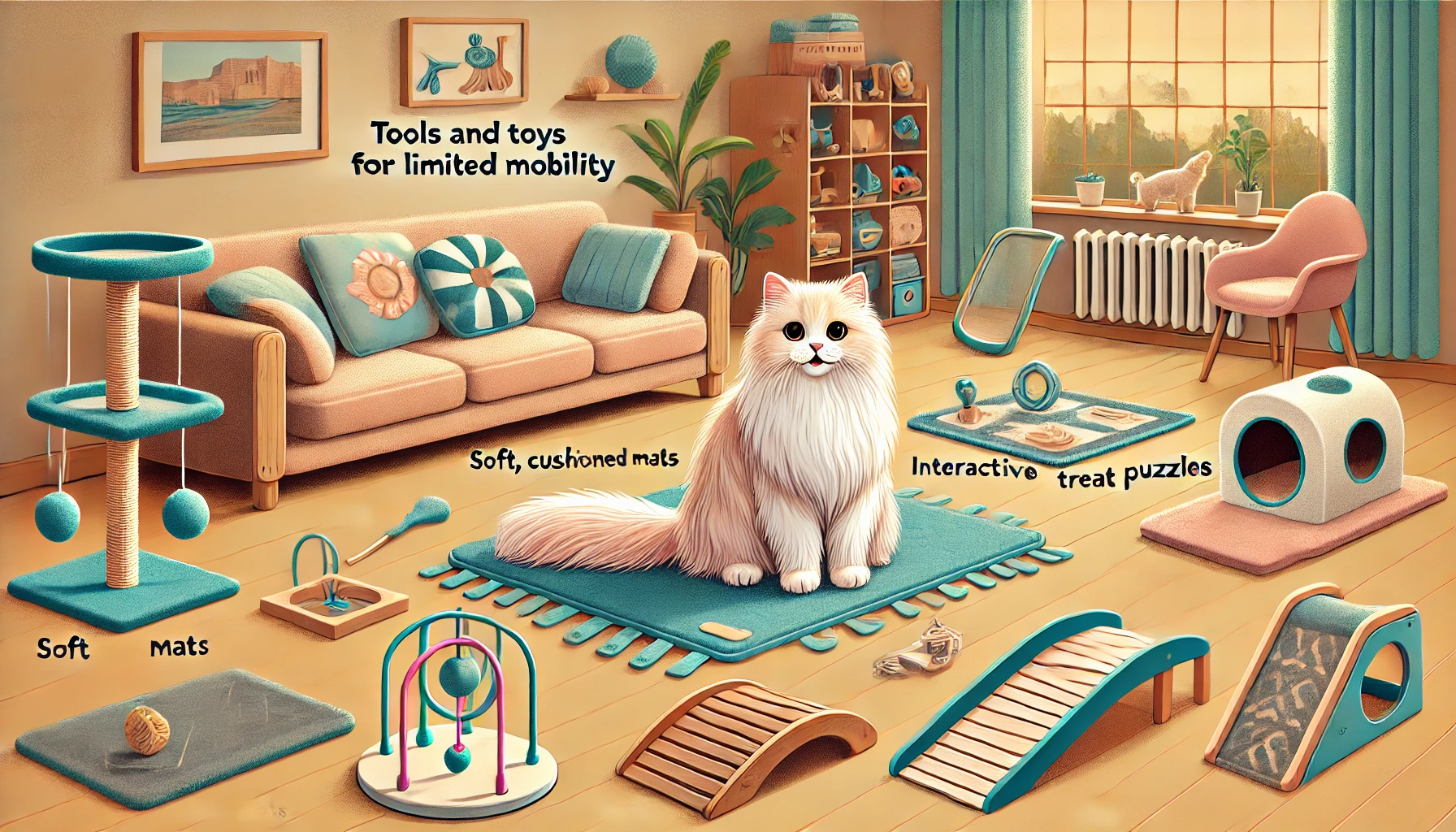
Tools and Toys for Cats with Limited Mobility
There are plenty of tools and toys that can keep your arthritic cat active and entertained without overexertion.
These tools encourage light movements and improve mobility:
- Soft, Cushioned Mats: These provide cushioned areas where your cat can stretch and rest comfortably without putting pressure on their joints.
- Interactive Toys: Treat puzzles stimulate mental and physical activity, promoting gentle exercise.
- Ramps and Steps: Provide ramps or small steps to help your cat reach elevated areas without jumping, reducing strain on the joints.
- Heated Beds: Heat can soothe aching joints, and heated beds offer a warm, cozy place for arthritic cats to rest.
By incorporating safe exercises and tools that support gentle movement, you can help your cat stay mobile and better manage their arthritis.
Regular, appropriate activity is key to maintaining your cat’s health, comfort, and happiness.
Gentle exercises are crucial to improving your cat’s mobility while avoiding strain on the joints.
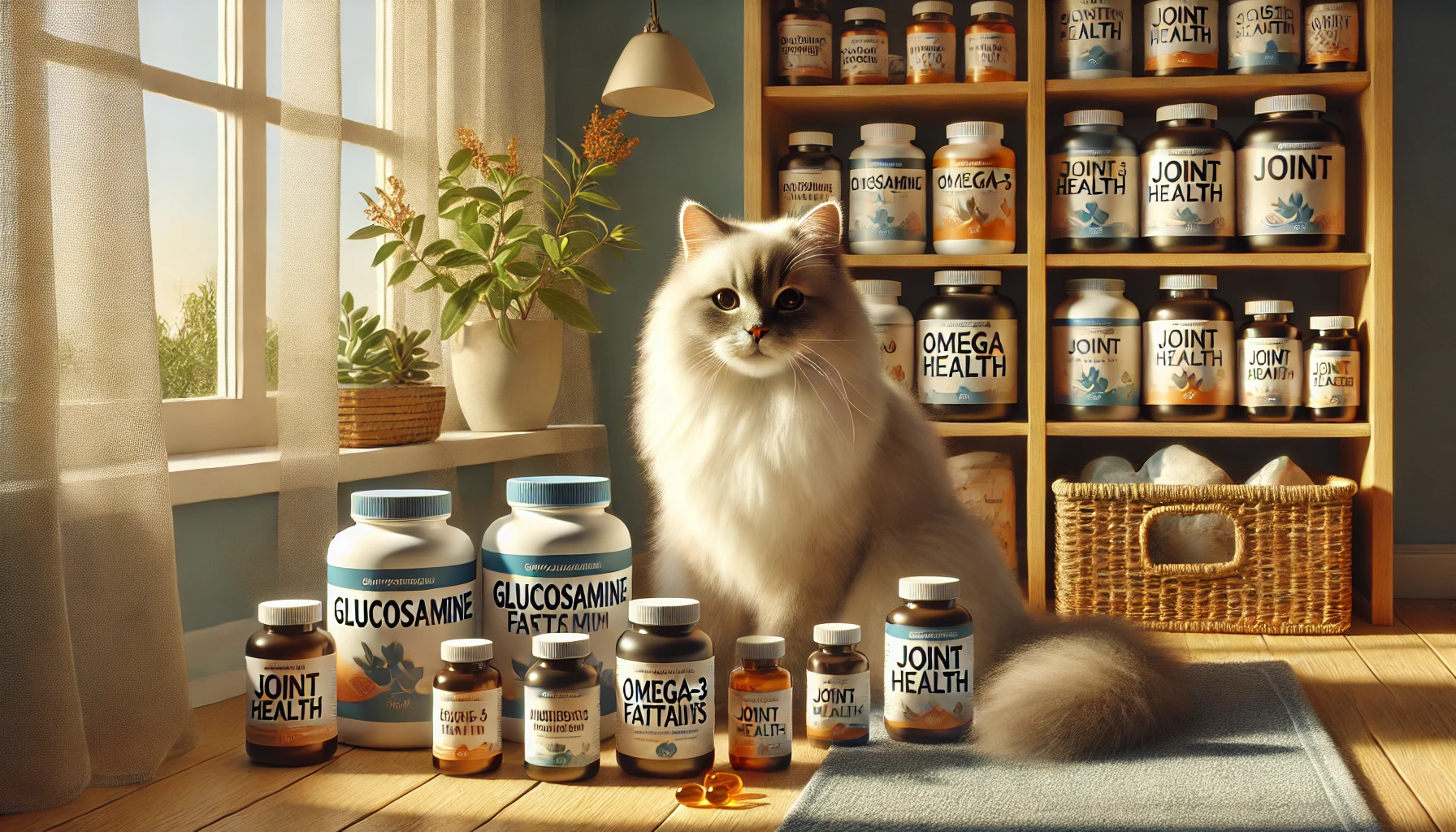
Supplements for Cats with Arthritis: What You Should Know
Supplements play a central role in the management of cat arthritis through their support of joint health and pain reduction.
While dietary changes and exercises are indispensable, supplements are important in offering additional help for improvement in mobility and reduction in inflammation.
Adding appropriate supplements to your cat’s regimen can ease some of the symptoms associated with arthritis and generally improve their quality of life.
This section covers some of the best supplements your feline friend can benefit from if they are suffering from arthritis, along with their essential benefits.

Top Supplements Helping in Joint Health
There are several types of supplements that are generally suggested for managing cat arthritis.
These supplements help maintain joint health, reduce inflammation, and enhance mobility.
The following are some of the best supplements to combat cat arthritis:
- Glucosamine: This supplement helps in maintaining the health of cartilage and, to a certain degree, can slow down joint deterioration. It is one of the most common supplements suggested for treating arthritis in both humans and animals.
- Chondroitin: Usually paired with glucosamine, chondroitin works by inhibiting enzymes that damage cartilage, promoting joint repair, and reducing inflammation.
- Omega-3 Fatty Acids: Omega-3 oils, especially those of fish oil origin, have anti-inflammatory properties that help reduce inflammation and pain in the joints.
- MSM (Methylsulfonylmethane): MSM contains anti-inflammatory properties that help support joint health by reducing swelling and increasing flexibility.
- Hyaluronic Acid: This supplement helps lubricate the joints and restore the shock-absorbing properties of cartilage, making movement easier for arthritic cats.
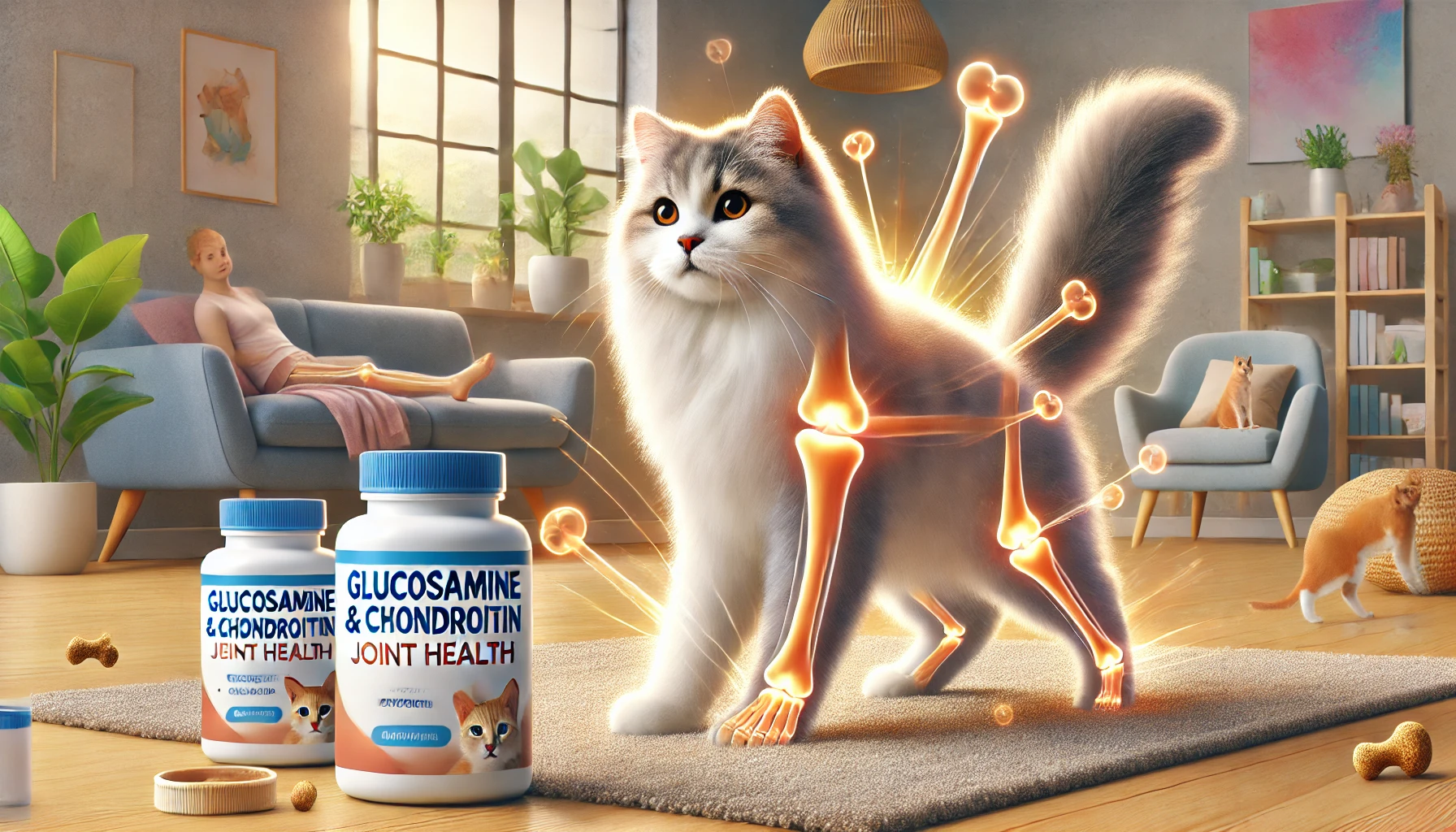
How Glucosamine and Chondroitin Help
Glucosamine and chondroitin are among the best-studied supplements for pet arthritis.
These supplements help prevent the degeneration of cartilage, reduce inflammation, and slow down the progression of arthritis.
Glucosamine stimulates the construction or repair of cartilage tissue, while chondroitin prevents enzymes involved in its breakdown.
Together, these supplements can enhance joint function and reduce pain in cats suffering from arthritis.
Many veterinarians recommend glucosamine and chondroitin supplements as part of a long-term management plan for arthritis.
These supplements are generally well-tolerated in cats, but it is crucial to follow the recommended dosage and consult your veterinarian before adding any supplement to your cat’s diet.
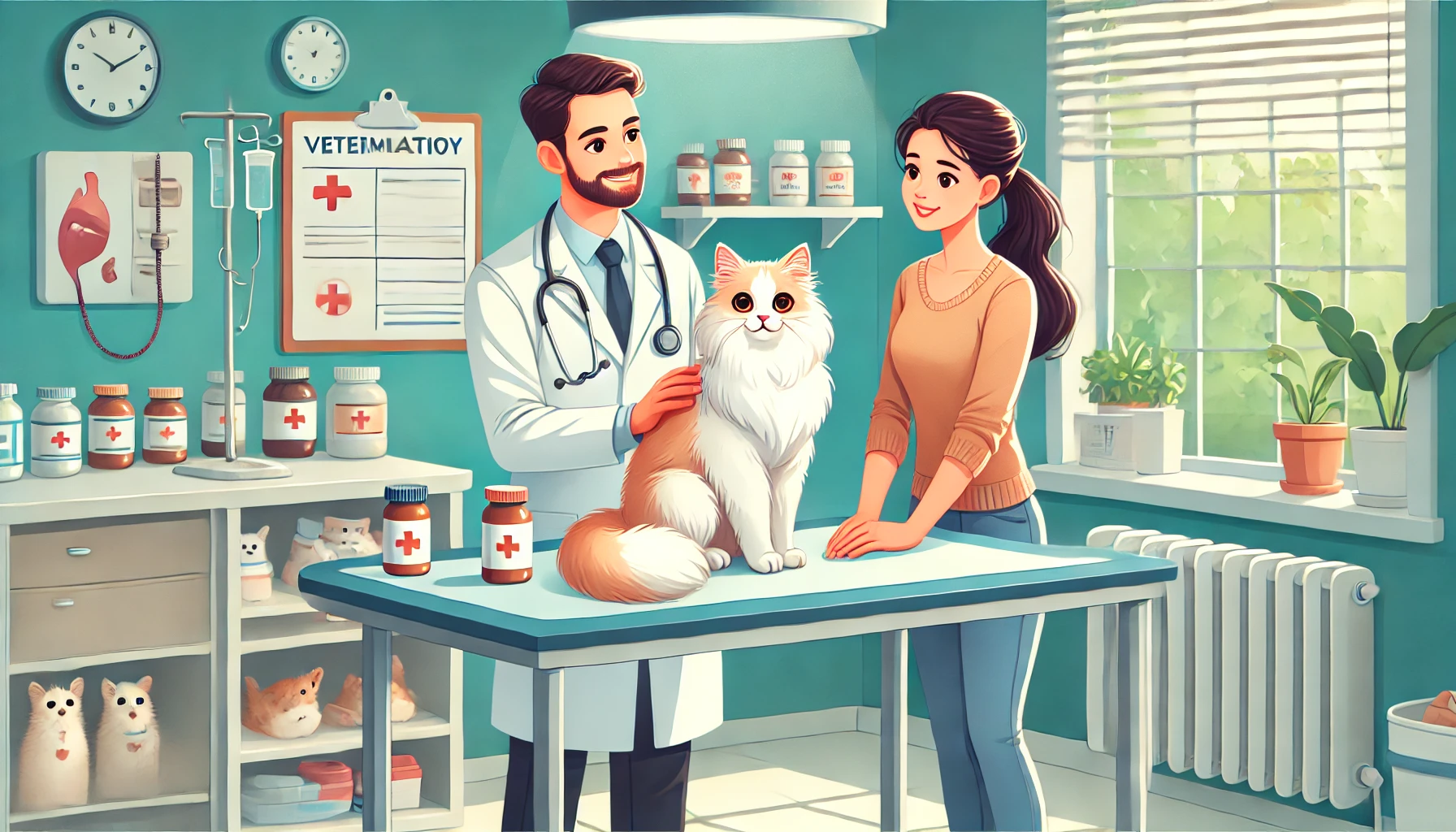
Consultation With Your Vet About Supplementation
It is always important to consult your veterinarian before adding supplements to your cat’s regimen.
Your vet can provide guidance on the most appropriate supplements for your cat’s specific needs and recommend the correct dosages.
Not all supplements are safe for every cat, and certain medical conditions can affect how your cat tolerates supplementation.
Your veterinarian will monitor your cat’s progress and adjust the treatment plan if necessary.
Regular check-ups are essential to ensure that the supplements are providing the intended benefits and to avoid any potential side effects.
When administered properly, supplements are one of the most important components of managing arthritis in cats.
Along with an appropriate diet, exercise, and quality veterinary care, supplements can significantly improve the comfort and mobility of your feline companion.
Supplements like glucosamine and Omega-3 fatty acids play a central role in managing arthritis by reducing inflammation and supporting joint health.
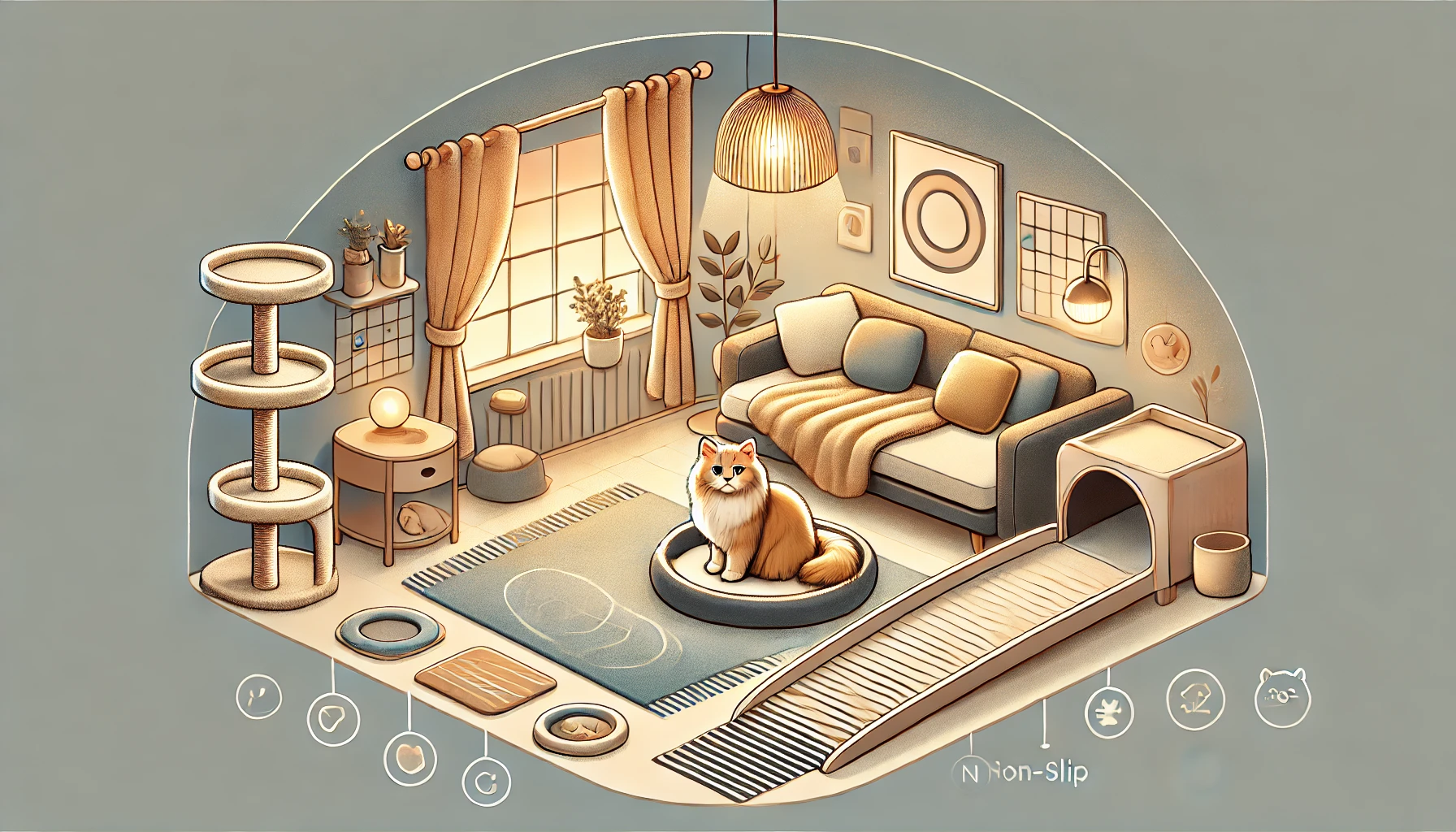
Creating a Comfortable Home Environment for Arthritic Cats
The home environment can play a significant role in the comfort and welfare of arthritic cats.
Simple adaptations to your living space can minimize stress on your cat’s joints and facilitate daily activities with more ease.
A safe, comfortable, and arthritis-friendly space will help your cat move with less pain and discomfort, improving their overall quality of life.
In this section, we will explore practical ways to build a home environment that supports your cat’s mobility and comfort.
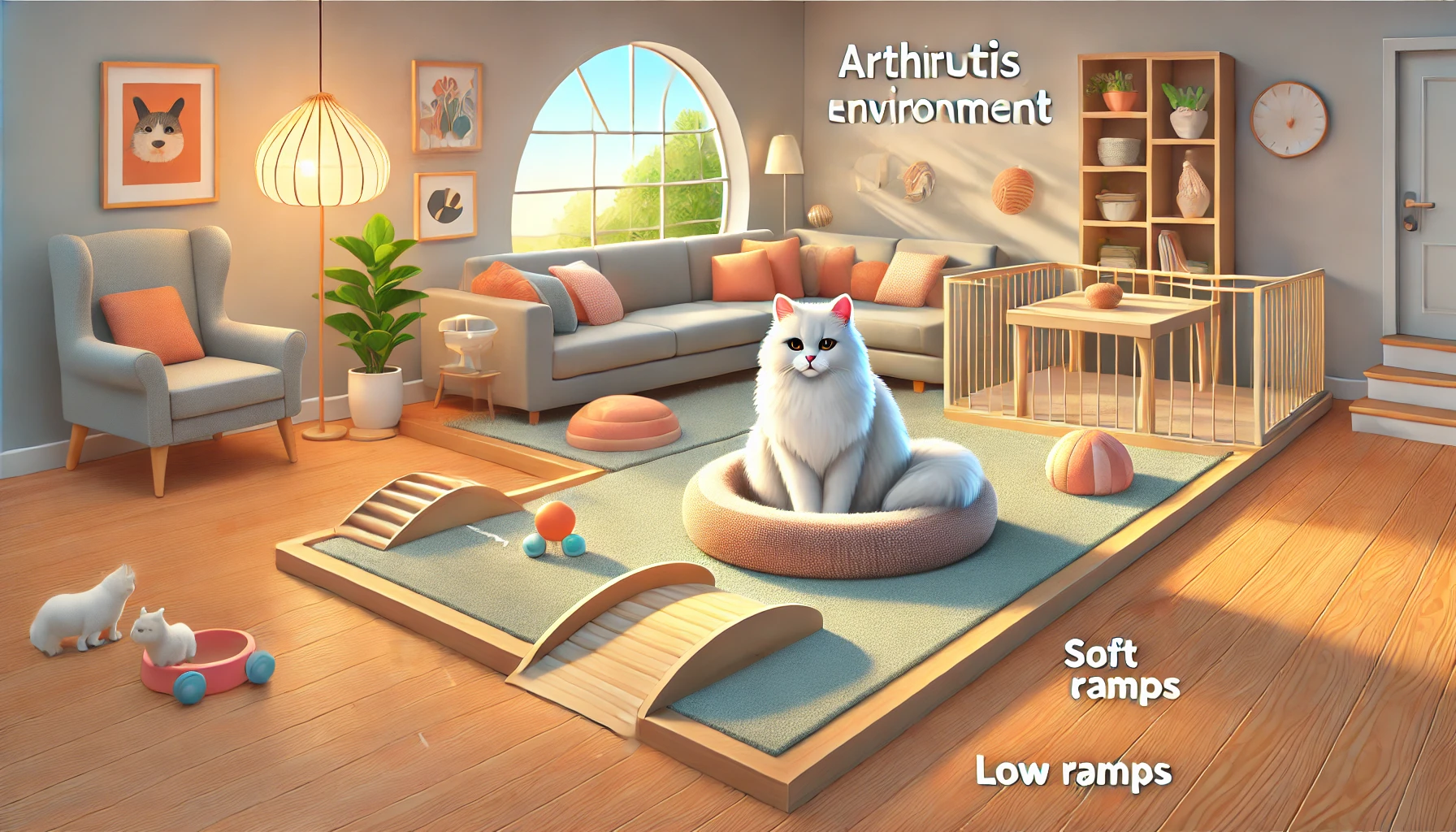
Creating an Arthritis-Friendly Environment
One of the most important ways to help your cat get around without stressing their joints unnecessarily is by making your home more accessible.
Here are some effective ways to set up an arthritis-friendly space:
- Provide Soft Bedding: Soft cuddle beds or blankets can be comforting for your cat and relieve pressure on their joints, especially in areas where they frequently sleep.
- Accessible Resting Areas: Ensure your cat has access to resting areas without needing to jump or climb. This may involve placing their bed or favorite resting spot on the floor or using ramps to enable access to higher locations.
- Install Ramps or Steps: Ramps or small steps can facilitate your cat’s access to high couches, beds, or windowsills without requiring them to jump, reducing joint strain.
- Ensure Safe, Non-Slip Surfaces: Cats with arthritis may struggle to walk on slippery floors made of hardwood or tile. Placing rugs or mats in essential areas can help prevent slipping, making it easier for your cat to move around.
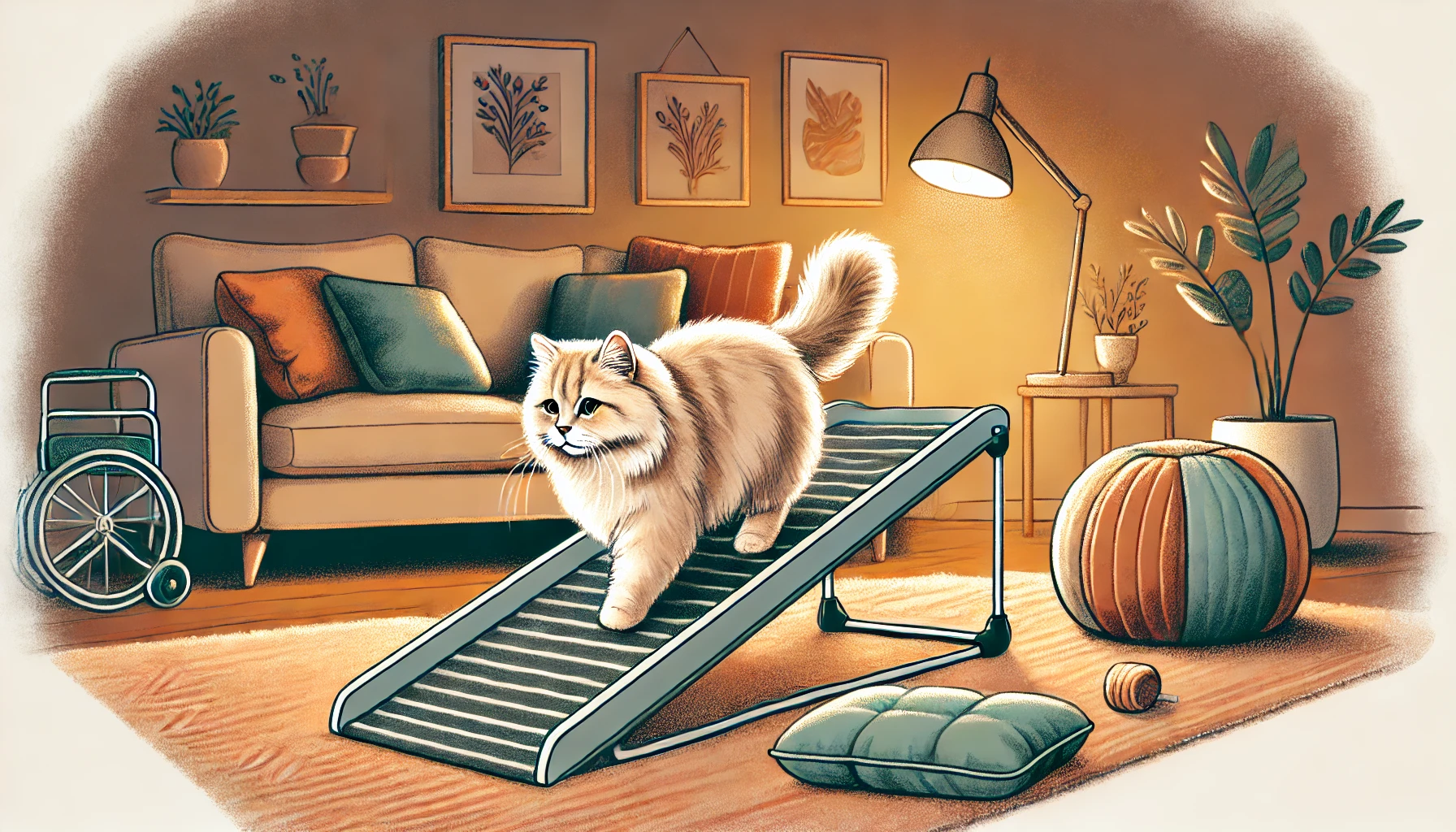
Using Ramps and Cushions to Support Mobility
Ramps and cushions are among the best ways to support your arthritic cat’s mobility.
Placing these tools around your home allows your cat to move more comfortably with less stress on their joints.
Ramps and cushions are particularly useful for elderly cats who still want to reach their favorite places but can no longer jump as they used to.
Consider the following:
- Ramps for Elevation: Ramps can help your cat access elevated areas like window perches or beds. They provide a gentle incline, minimizing the need for jumping.
- Cushioned Mats: Placing cushioned mats in areas where your cat likes to rest offers extra joint support and comfort.
- Portable Steps: Small steps near couches, beds, or other elevated surfaces allow your cat to climb without straining their joints.
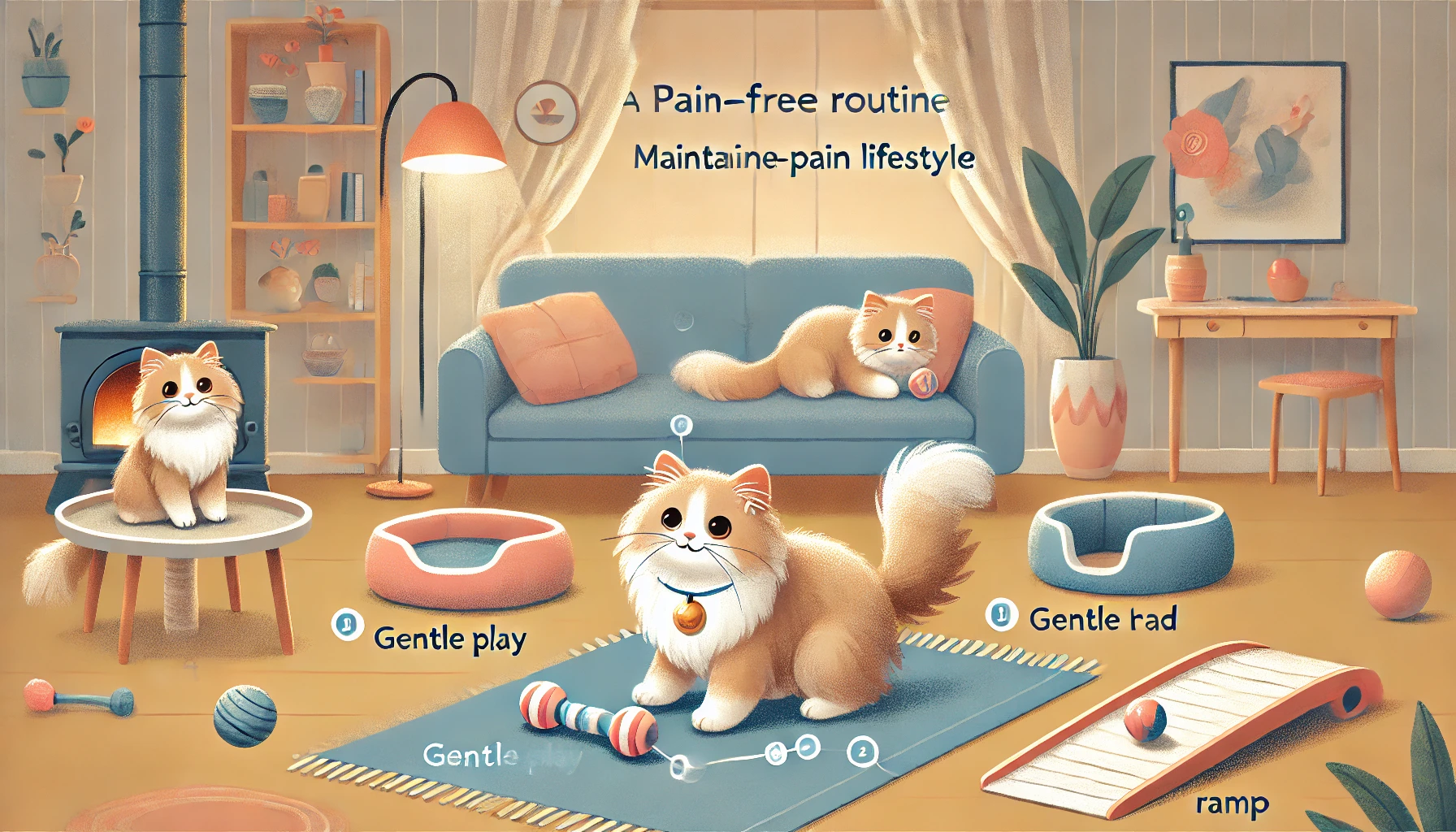
Maintaining a Pain-Free Routine for Cats with Arthritis
Establishing a routine that takes your cat’s arthritis into account can significantly enhance their comfort.
Monitor your cat for any signs of pain and make changes to your home setup as needed.
Here are some tips for maintaining a pain-free routine:
- Keep Food and Water Accessible: Ensure that your cat’s food and water bowls are placed in accessible locations and at comfortable heights to prevent stretching or straining, which can exacerbate joint pain.
- Heated Beds or Pads: Arthritic cats benefit from heated beds or pads, especially during colder months. Heat therapy is a natural way to soothe pain and stiffness in cats with arthritis.
- Activity Monitoring: Encourage regular but gentle play without overexertion. Provide ample rest between light exercise sessions to avoid stressing their joints.
- Regular Grooming: Cats with arthritis may struggle to groom themselves. Regular brushing helps maintain their coat and improves their comfort.
By making a few simple adjustments to your home and routine, you can create a comfortable, pain-free environment for your arthritic cat.
These changes, along with proper veterinary care and supplementation, will go a long way in improving your cat’s mobility, reducing pain, and enhancing their quality of life.
Making simple adjustments to your home environment, such as adding ramps and heated beds, can help your cat move comfortably and reduce joint pain.
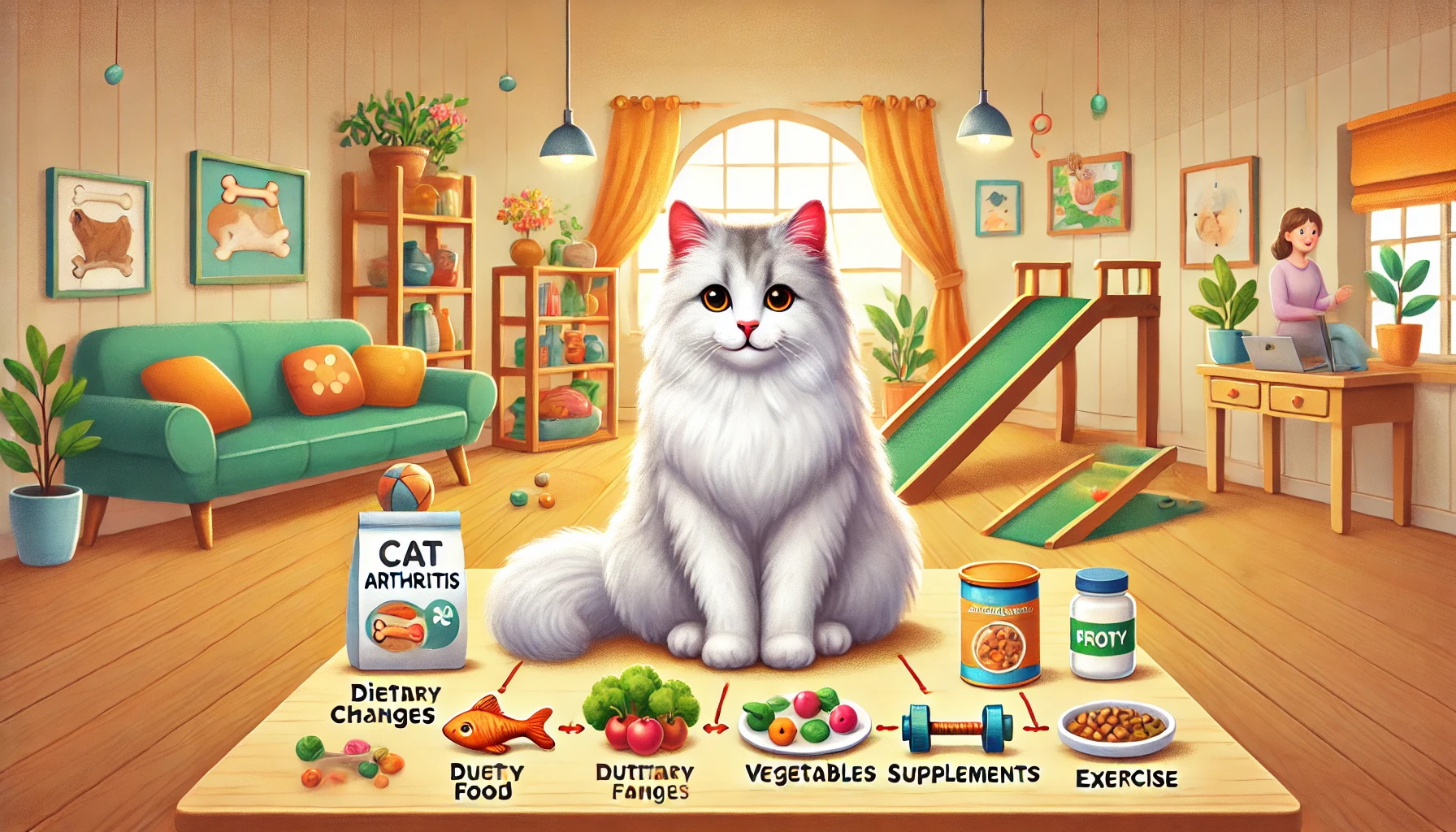
Conclusion: Management of Cat Arthritis through Dietary Changes and Exercises
The management of cat arthritis is a long and, at times, patience-requiring process.
However, with the right approach, you can make a significant difference in your cat’s life.
By incorporating dietary changes, supplementation, gentle exercises, and making modifications to their living environment, you can reduce the pain and discomfort caused by arthritis.
These strategies work together to support joint health, reduce inflammation, and improve mobility in cats affected by this condition.

The Significance of a Balanced Diet
A balanced diet is crucial in managing arthritis in cats.
A diet rich in Omega-3 fatty acids, glucosamine, and chondroitin can help reduce inflammation, repair cartilage, and improve joint flexibility.
Supplements can further enhance your cat’s joint health, making it easier for them to maintain mobility without painful activity.
- Add anti-inflammatory nutrients such as Omega-3 fatty acids to their diet.
- Include glucosamine and chondroitin to help repair joints and maintain joint health.
- Always consult your veterinarian before adding supplements to your cat’s diet to ensure safety and effectiveness.
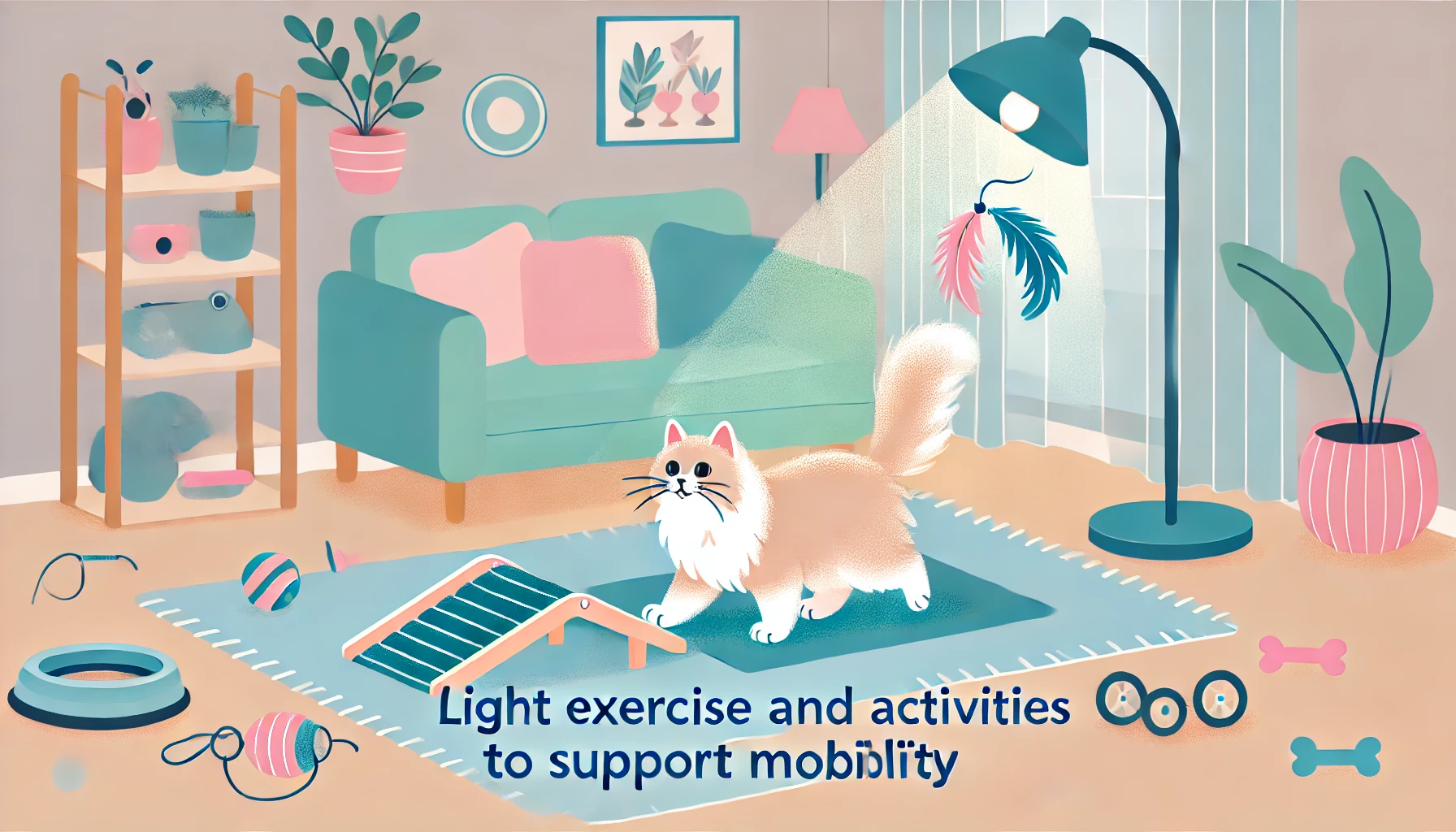
Light Exercise and Activities to Support Mobility
Regular, low-impact exercises help your cat maintain mobility, improve circulation, and prevent joint stiffness.
Gentle play sessions, controlled walks, and using ramps or steps can encourage movement without overstressing your cat’s joints.
- Use interactive toys for light exercise to keep your cat active.
- Provide ramps and soft bedding for easier access around the home.
- Monitor their activity level and ensure they have plenty of rest between exercises.
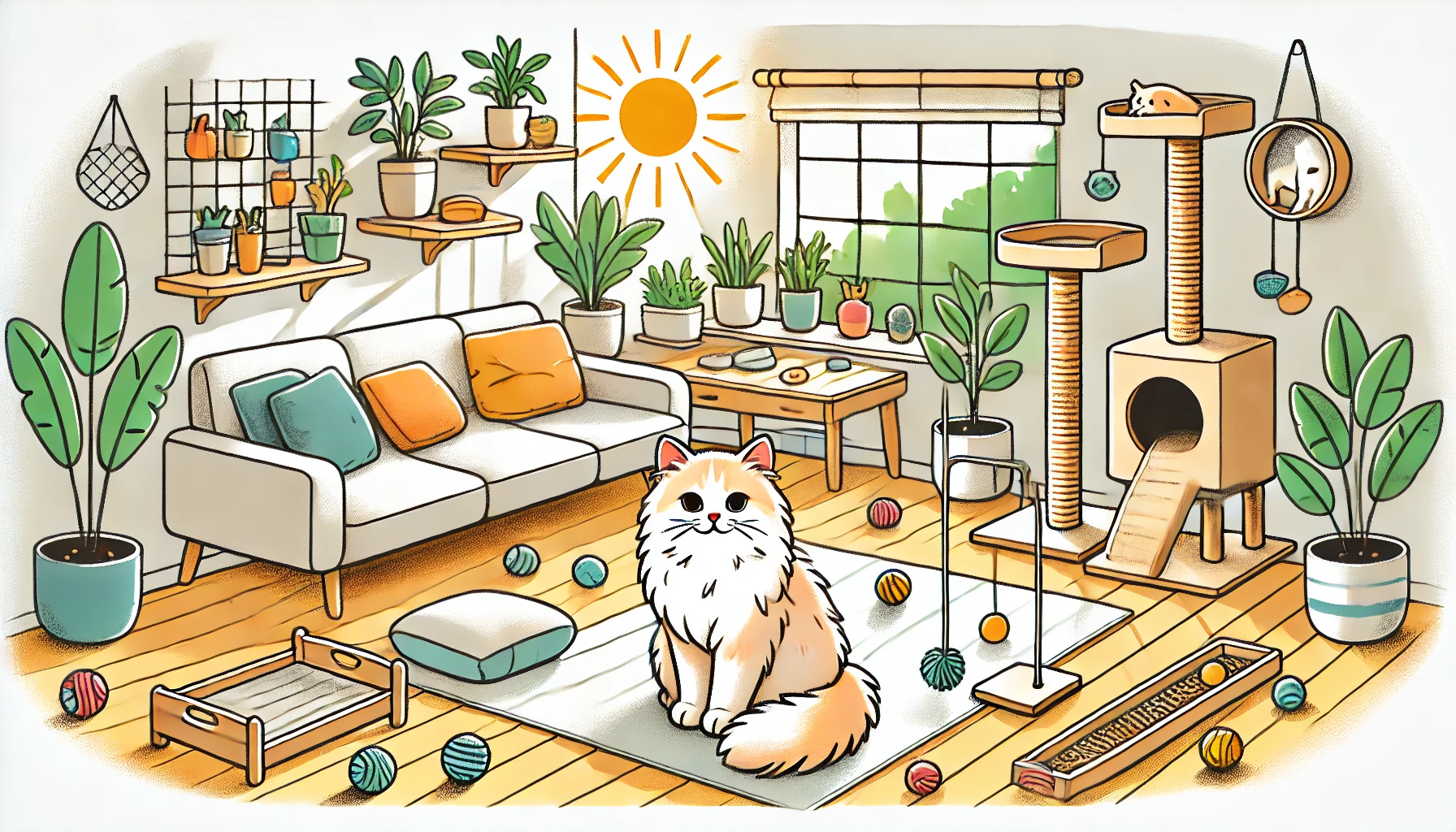
Creating a Cat-Friendly Environment
Creating a cat-friendly home environment is essential in managing cat arthritis.
Adding ramps, cushioned mats, and ensuring non-slip surfaces will make it easier for your cat to move around with minimal pain.
This setup allows your arthritic cat to navigate their environment comfortably without straining their joints.
- Set up ramps and steps to assist with mobility and reduce jumping.
- Use heated beds or cushions for comfort and to soothe aching joints.
- Ensure easy access to favorite resting spots without requiring your cat to jump or climb.
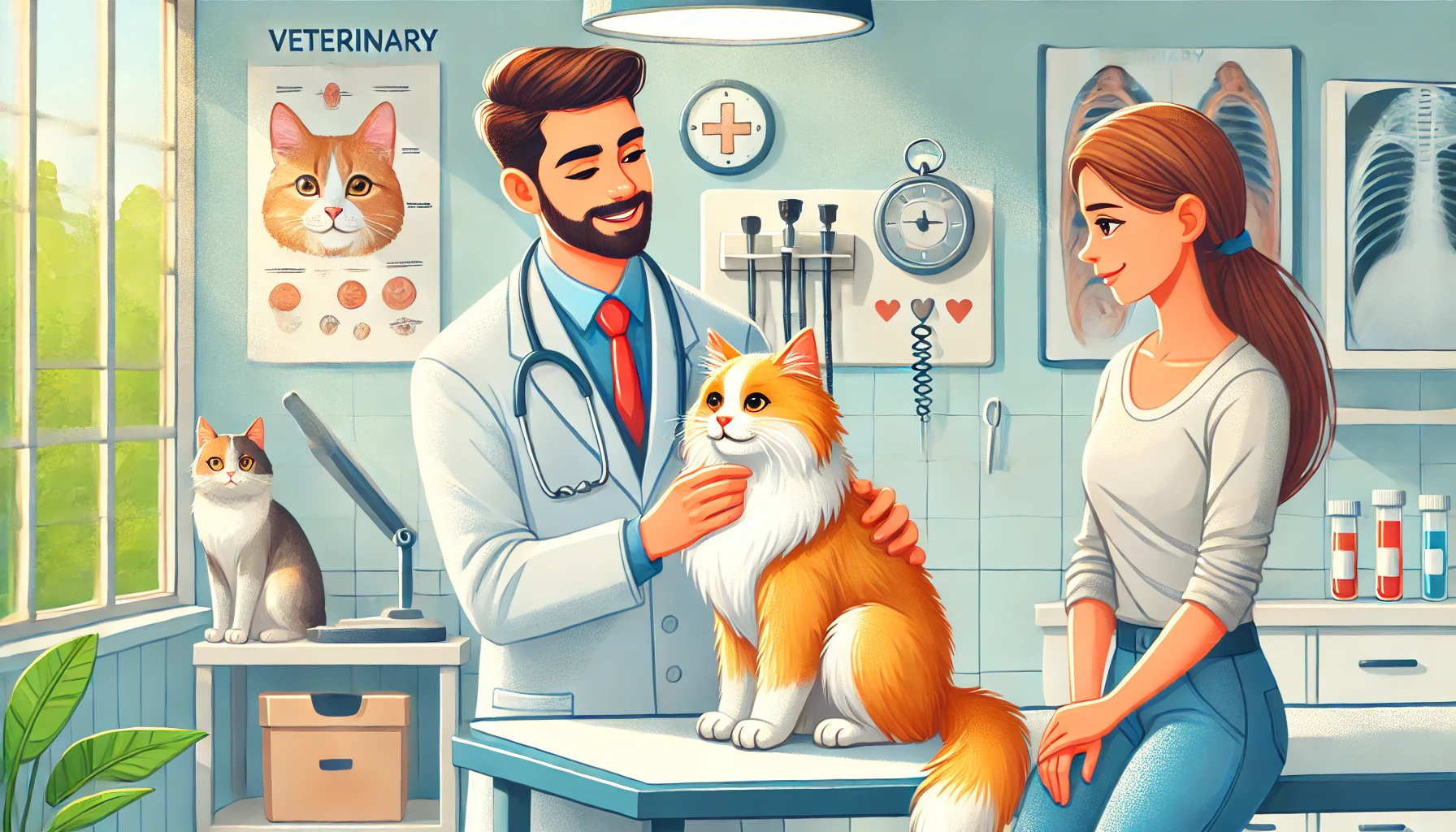
Consultation and Veterinary Care
Veterinary care is one of the most critical aspects of managing arthritis in cats.
Regular check-ups, professional advice, and adjustments to your cat’s care plan will help ensure effective management.
Always consult your veterinarian before introducing any supplements or making significant changes to your cat’s routine.
By incorporating these strategies—ranging from diet and exercise to creating a comfortable home environment—you can make a significant difference in managing your cat’s arthritis.
With the right support, you can improve your cat’s mobility, reduce pain, and help them live a more comfortable, pain-free life.
With proper diet, supplements, exercises, and a comfortable environment, you can significantly reduce the pain and discomfort caused by arthritis in your cat.
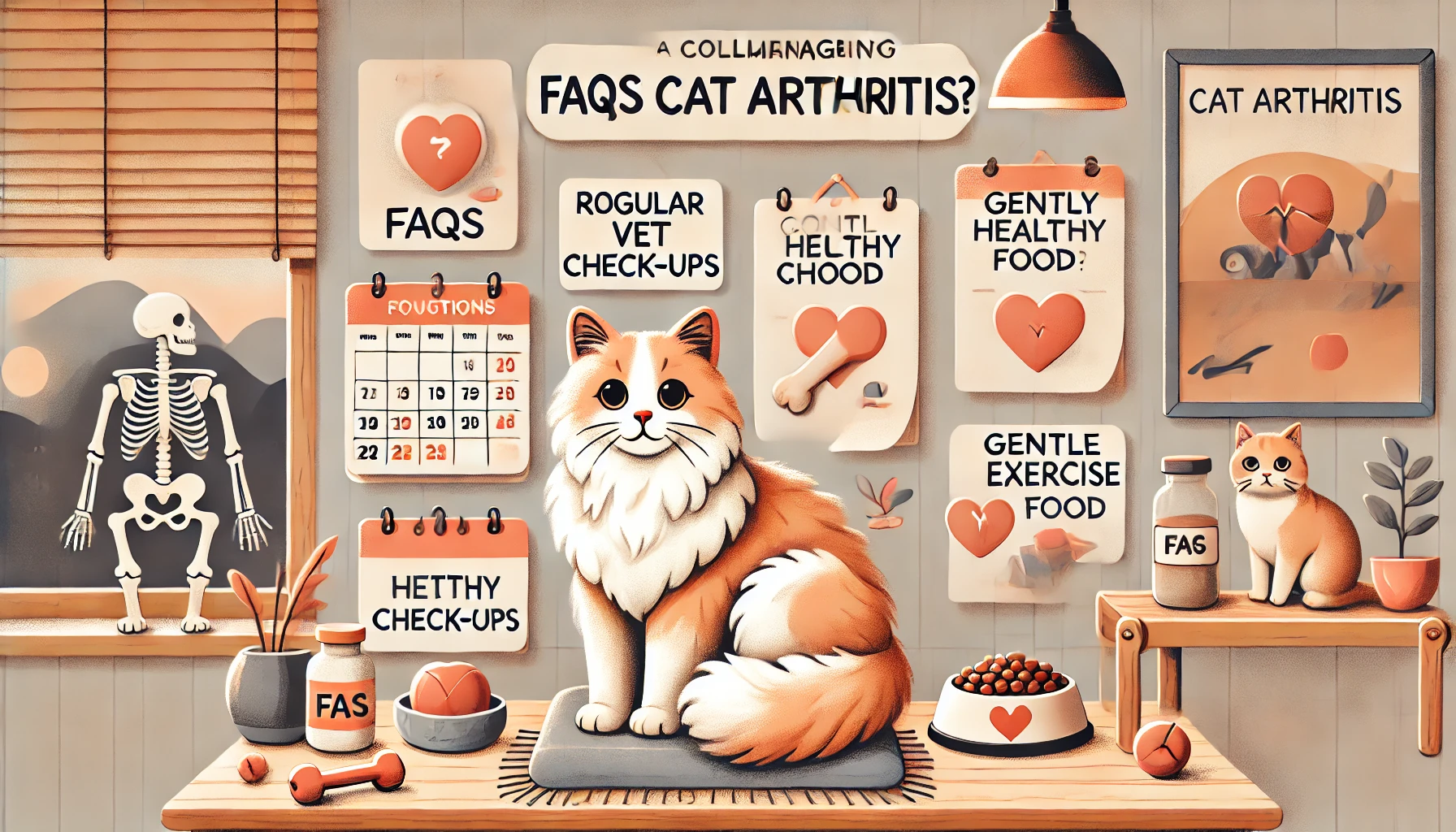
FAQs About Managing Cat Arthritis
Following are some of the most frequently asked questions about managing cat arthritis through diet, exercises, and other methods.
These answers will give you a glimpse into how you can help your arthritic cat live a healthier and more comfortable life.
What are the signs of arthritis in cats?
Common symptoms of cat arthritis include limping, stiffness, a decline in jumping, a decrease in grooming, and irritability.
Cats may also struggle with climbing stairs and visibly experience discomfort when touched near their joints.
Can diet improve the condition of cat arthritis?
Yes, a diet rich in Omega-3 fatty acids, glucosamine, and chondroitin can reduce inflammation, support joint health, and improve your cat’s overall mobility.
This is a vital aspect to consider when managing cat arthritis.
Which supplements are best for arthritis in cats?
Glucosamine and chondroitin, Omega-3 fatty acids, MSM, and hyaluronic acid are commonly recommended supplements that decrease inflammation, repair cartilage, and improve joint health in arthritic cats.
How can I exercise my cat with arthritis?
Engage your arthritic cat in light, low-impact activities: short, frequent play with interactive toys; gentle leash walks; and encouraging the use of ramps to avoid stressing their joints while keeping them mobile.
What can be done around the house to accommodate an arthritic cat?
Placing ramps to high areas, cushioned mats to step onto, heated beds for sleeping, and ensuring non-slip surfaces will alleviate stress on your cat’s joints and make it easier for them to maneuver around the house.
Should I consult a vet before adding supplements?
Yes, always consult your veterinarian before introducing new supplements to ensure they will not harm your cat and that the recommended dosage is suitable for their condition.
Can heat therapy help cats with arthritis?
Yes, heat therapy—using heated beds or pads—can ease joint pain and stiffness, especially during colder seasons.
It provides natural comfort for arthritic cats.





